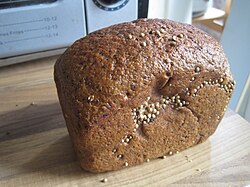Borodinsky bread
 | |
| Type | Bread |
|---|---|
| Main ingredients | a mixture of rye and whole wheat flour, yeast, salt, barley malt syrup, black treacle or molasses, coriander and caraway seeds |
Borodinsky bread (Template:Lang-ru) is a dark brown sourdough rye bread of Russian origin, traditionally sweetened with molasses and flavored with coriander and caraway seeds.
Preparation
Borodinsky bread is traditionally made (with the definite recipe fixed by a ГОСТ 5309-50 standard) from a mixture of no less that 80% by weight of a whole-grain rye flour with about 15% of a second-grade wheat flour and about 5% of rye, or rarely, barley malt, leavened by a separately prepared starter culture made like a choux pastry, by diluting the flour by a near-boiling (95-96°C) water, and adding the yeast after cooling the mix to 65-67°C, but then mostly inoculated by the previous batches of dough instead of the dry yeast. It is then sweetened and colored with beet sugar molasses, and flavored with salt and spices, of which the coriander seed is required, and caraway is optional, but still quite popular.
Legend of origin
A popular but really unsubstantiated legend states that this bread traces its name to Margarita Tuchkova, a widow of Napoleonic Wars general Alexander Tuchkov, who perished at Battle of Borodino. His widow established a convent at a former battlefield, an abbess of which she eventually became, and its nuns had reportedly come up with the bread's recipe to serve at mourning events, thus, a dark, solemn color, and with round coriander seeds representing a deadly grapeshot.
No sources support this legend, and the name of this bread most probably first appeared after the October Revolution (1917), as no mention of this name was made before 1920. In fact, the modern recipe did not appear in print before 1933, first in internal memos of a Moscow baking plant. However, in the literature of breadbaking of the end of 19th century, a number of similar recipes exist, though caraway seeds were usually used instead of coriander.
